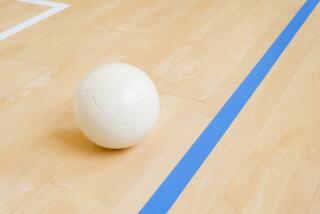SDSU Men Hoping Power Is On Again
- Share via
SAN DIEGO — Men’s volleyball isn’t all that different than football--one good hit usually terminates the play.
And that is the problem.
At a men’s college volleyball game, one is not likely to see anything resembling a rally. Men’s volleyball is a power game, and if that doesn’t sound like a problem, consider the plight of San Diego State.
Back in the early 1970s, the Aztecs repeatedly drew crowds of more than 4,000 to Peterson Gym, which has seating for 3,800.
Of course, the turnstiles were whirring mostly because the Aztecs were winning. In 1973, SDSU claimed the NCAA title, to this day the school’s only national championship.
But soon thereafter, the crowds got smaller. That the team stopped winning championships had a lot to do with it. But the coach at that time, Jack Henn, says there was more to it.
In 1972, federal law Title IX mandated that Division I universities fund a minimum number of women’s programs, giving rise to women’s volleyball on many campuses, including SDSU.
People suddenly had a choice of tuning out the quick pass-set-kill of men’s volleyball for the women’s game.
“The women’s game was more marketable because it had longer rallies,” Henn said.
It was not only more marketable, but because of Title IX, it was less susceptible to an accountant’s scalpel.
Henn left the men’s program after the 1974 season. The Aztecs continued to make it to the Western Regionals on a consistent basis but never repeated the championship year.
In 1984, in the school’s never-ending attempt to keep red ink from bleeding all over the athletic budget, Coach Duncan McFarland and assistant Mark Warner were told their sport was being dropped . . . unless they could raise $38,000.
McFarland and Warner, coming up with one of SDSU’s all-time digs, raised the money in less than two months and saved the program.
“We just decided it was worth it,” McFarland said. “We could see the sport’s popularity was growing and felt that local high schools would be playing it in a few years.”
Using donated funds, men’s volleyball made it through the 1987 season and returned to the school’s budget in 1988. Henn returned as head coach last year, and Warner is now his assistant. Their goal is to bring the program back to the level it had reached in the early 1970s. This weekend’s ASICS Grand Prix at SDSU, a tournament that includes nine of the nation’s top 20 teams, will be a measuring stick of their progress.
“At least now we’ll have some continuity in the program,” Warner said. “And that will help us downstream.”
The current coaches poll ranks the Aztecs 12th in the nation, which would indicate they’re on the way back to national contention.
Not so fast.
First of all, the Aztecs play in the Western Intercollegiate Volleyball Assn., from which every NCAA champion has emerged.
Moreover, nine of the 11 teams ranked ahead of SDSU come from the WIVA.
Thus, men’s volleyball success in Southern California isn’t measured by the top 20 but by who beats the top two or three teams such as UCLA, Stanford and Hawaii.
“We haven’t had success in a while,” Warner said. “And by success I mean we haven’t beaten the top teams. The first step toward that is believing we can do it. As soon as the players do that and knock off one of the top teams, in a year or two maybe we can sneak back up there.
“The problem is the league’s so tough . . . with Stanford and UCLA . . . these teams are just a little bit above us. Now, I’m not saying we can’t beat them, but for us to do that, we would have to play mistake-free, and they would have to be a little bit down.”
The Aztecs have a ways to go to match the skill of their earlier teams.
“That ’73 team was an unusual bunch of guys, “ Henn recalled.
This year’s varsity, which opened with a 3-2 loss to No. 10 Cal State Northridge, suffered a setback when Mike Schlegel, the leading hitter from last season, decided to quit the program and try out for the U.S. national team.
Henn has been forced to juggle his lineup.
“We’re going to have to spread some things around a little,” Henn said.
Schlegel had 416 kills last season. Next in line was Eric Etebari with 270, meaning the Aztecs have a sizable spread to cover.
To do so, Henn has changed from a two-passer to a four-passer system. Against Northridge, it appeared to work: Four Aztecs had at least 13 kills. Douglas Potter, a 6-foot-4, 190-pound junior, had 19; Mike Mattarocci, a 6-8, 220-pound junior, had 17; Douglas Moreland, a 6-4, 190-pound sophomore, had 16 and Etebari, a 6-2, 195-pound junior, had 13.
“I think we’re going to be stronger this year,” Henn said. “We’re going to be bigger, which will hopefully translate into some quick points at the net.”
Now about those crowds.
“In a big match, say against UCLA, we might get 1,000 people,” Warner said.
But there are indications the larger gatherings may soon return.
“What you’re seeing now is interest in men’s volleyball through beach volleyball,” Warner said. “It’s really coming back. Plus there’s a lot of high school boys’ teams now (52 in San Diego). The sport is just growing by leaps and bounds.”
The game has become an even stiffer test of power, which isn’t so much of a problem any more.
More to Read
Go beyond the scoreboard
Get the latest on L.A.'s teams in the daily Sports Report newsletter.
You may occasionally receive promotional content from the Los Angeles Times.










